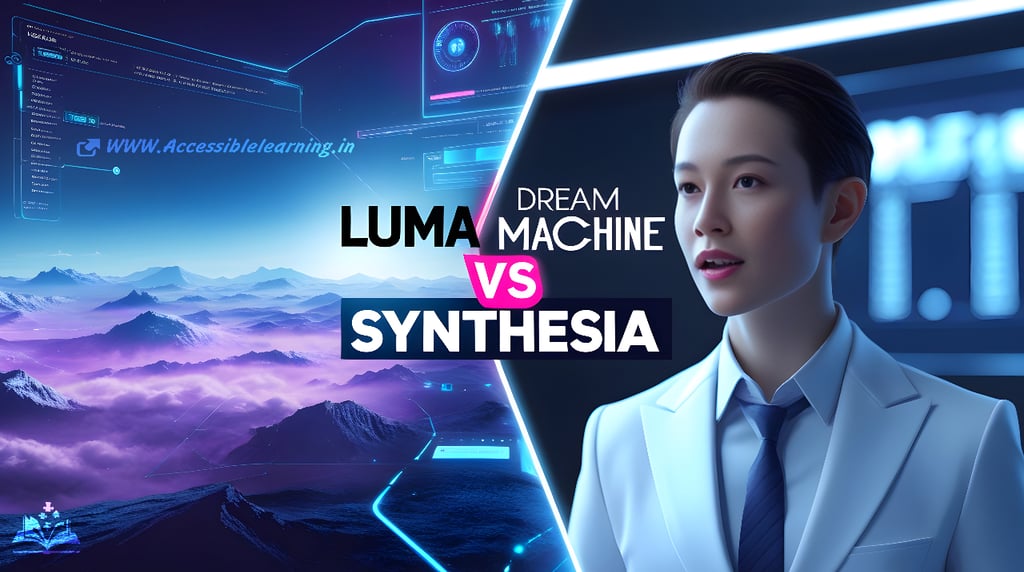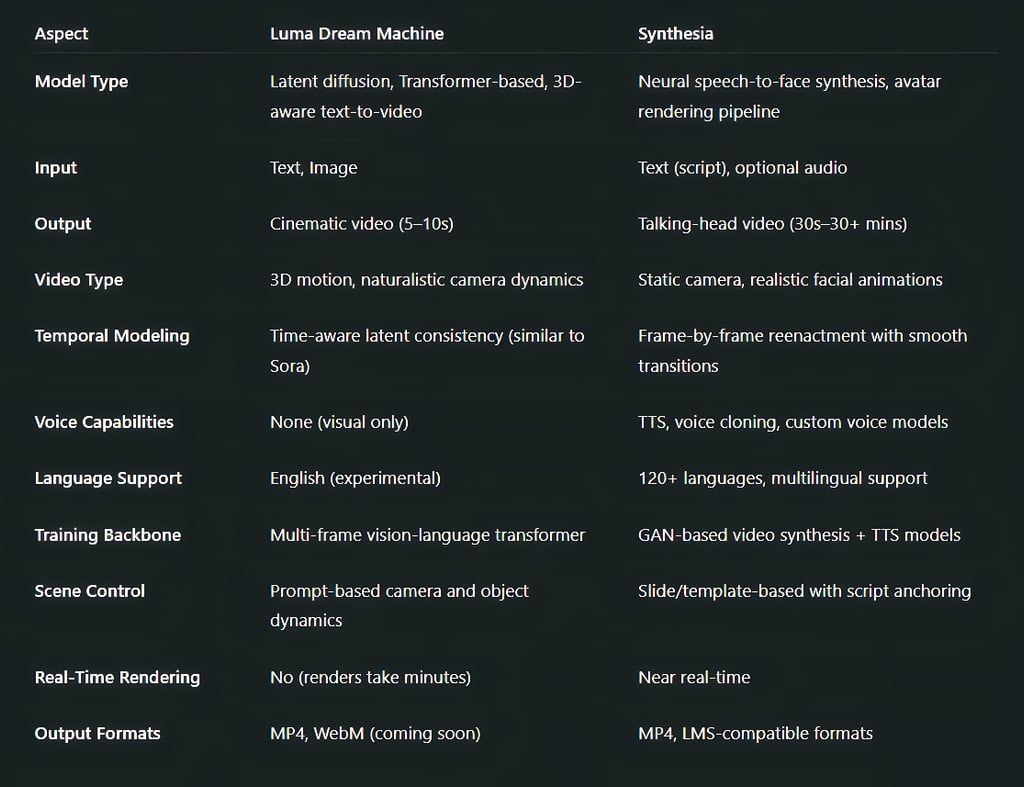
Luma Dream Machine vs Synthesia (2025): Technical Powerhouses in AI Video Creation
Discover the key differences between Luma Dream Machine and Synthesia in this 2025 deep dive. From cinematic AI video generation to avatar-powered business communication, explore how these two cutting-edge tools serve creators, enterprises, and tech enthusiasts with distinct technologies and use cases.
AI ASSISTANTAI ART TOOLSAI/FUTUREARTIST/CREATIVITY
Sachin K Chaurasiya
6/11/20254 min read


In 2025, the AI video generation space has matured rapidly, offering creators a range of tools that blend technical brilliance with creative freedom. Two frontrunners in this landscape—Luma Dream Machine and Synthesia—serve vastly different needs but share the same goal: making video creation faster, smarter, and more accessible.
Whether you're a deep tech enthusiast, a content creator, or a corporate professional, this in-depth comparison breaks down both platforms—from core architecture to real-world use cases.
What is Luma Dream Machine?
Luma Dream Machine is a foundational text-to-video model designed to generate short video clips from textual or visual prompts. Built by Luma AI—a company known for 3D reconstruction and photorealistic scene modeling—Dream Machine pushes the boundaries of spatiotemporal coherence in generative video.
Under the Hood: Luma Dream Machine Technology
Architecture: While not open-sourced yet, Luma likely employs Transformer-based architectures integrated with video diffusion models and latent space sampling.
Temporal Consistency: Luma excels at maintaining object integrity and camera motion across frames, solving a core problem in video diffusion (i.e., temporal flicker).
Multimodal Embeddings: Supports CLIP-like vision-language alignment to translate descriptive prompts into video assets.
3D Awareness: Inspired by NeRF and 3D Gaussian Splatting, it generates depth-aware camera movements—enabling rich cinematic visuals.
Training Data: Trained on large, proprietary datasets mixing open-domain video, movie clips, and 3D-rendered scenes.
Frame Rate & Length: Typically generates clips of 5–8 seconds at ~24 fps with resolution nearing 1080p.
Advanced Features
Depth consistency across motion.
Diffusion-style frame interpolation for smooth transitions.
Seamless camera path synthesis from text-based cues (e.g., “drone shot over a rainforest”).
Handles occlusion, shadow casting, and dynamic lighting.
What is Synthesia?
Synthesia is a video synthesis platform that uses neural rendering and speech-to-face models to generate talking-head videos. It has revolutionized business video production by making AI avatars indistinguishable (in many cases) from real humans.
Technical Foundation of Synthesia
Core Models: Synthesia integrates facial reenactment models (e.g., based on Wav2Lip, D-ID principles), text-to-speech (TTS) systems, and deepfake-like video stitching.
Avatar Training: Each avatar is trained on hours of high-definition video, using facial blendshape modeling and dynamic expression mapping to retain naturalism.
Language and Voice:
Uses multilingual neural TTS engines with tone control.
Offers voice cloning via speaker embedding models like ECAPA-TDNN or YourTTS.
Enterprise Focus: API access, SCORM integration for LMS platforms, SSO authentication, and ISO/IEC security standards for privacy compliance.
Advanced Features
Custom avatar APIs (White-labeled solutions).
Lip-sync accuracy is based on viseme-to-phoneme mapping.
Supports closed captioning, subtitles, and script automation.
Fine-tuning for brand-specific accents, dress code, and language dialects.
Real-time avatar testing via script input and TTS preview.




When to Use Luma Dream Machine vs Synthesia
Use Luma Dream Machine if you
Need rich, aesthetic visuals with complex backgrounds.
Are you experimenting with AI filmmaking, short-form art, or creative storytelling?
Want to generate dynamic, immersive clips from scratch.
Are you building a music video, VFX asset, or animated scene prototype?
Use Synthesia if you
Need a training or product demo video in multiple languages.
Want a scalable way to onboard customers or employees?
Require a professional avatar to speak your brand message with a personal touch.
Are producing corporate learning modules, pitch decks, or explainer videos.
Future Outlook
Luma AI is positioning Dream Machine as a direct competitor to OpenAI’s Sora, with plans for longer sequences, higher resolution, and possibly interactivity or scene editing.
Synthesia continues to push toward autonomous avatar agents, adding gesture control, eye movement realism, and real-time voice-over sync for Zoom-style virtual avatars.
In summary:
Luma Dream Machine = Hollywood-grade AI creativity.
Synthesia = Boardroom-grade AI professionalism.
If you’re working on imaginative, non-verbal cinematic videos, Luma is the bleeding-edge solution. For scripted, language-driven, multilingual communication, Synthesia is the corporate powerhouse.
Both are shaping the future of video content, but with radically different philosophies—and understanding that is key to choosing the right tool.
FAQ's
What is the main difference between Luma Dream Machine and Synthesia?
Luma Dream Machine is designed for cinematic and creative video generation using text or images, while Synthesia specializes in professional, avatar-based videos ideal for training, corporate communication, and multilingual presentations.
Can I use Luma Dream Machine for business presentations?
Not effectively. Luma is geared toward artistic or cinematic storytelling. It lacks structured avatar narration or business-focused templates that Synthesia provides.
Does Synthesia support custom avatars and voices?
Yes. Synthesia allows you to create custom avatars and offers voice cloning, multilingual support, and branded video solutions, especially tailored for enterprises.
Is Luma Dream Machine free to use?
Currently, Luma offers limited free access as it’s in beta. Advanced features and extended usage may become part of a paid plan in the near future.
Which platform is better for social media video content?
It depends on your content style:
For visually engaging, short cinematic clips, go with Luma Dream Machine.
For talking-head explainers or announcements, Synthesia is a better choice.
Do either of these platforms offer real-time video generation?
Synthesia provides near real-time video rendering for short scripts. Luma Dream Machine, being graphics-intensive and cinematic, usually takes a few minutes to process and generate each video.
Subscribe To Our Newsletter
All © Copyright reserved by Accessible-Learning Hub
| Terms & Conditions
Knowledge is power. Learn with Us. 📚


